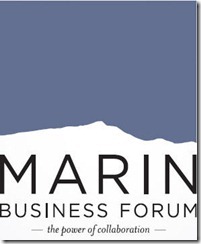Last Thursday was our quarterly gathering of the Marin Business Forum, a networking event to give local business leaders a chance to share ideas and exchange contact information. The guest speaker was Pete Daffern, CEO of Clairmail, talking about corporate growth strategies, and the consensus from those in attendance was that Pete’s insight was quite valuable.
Pete has a lot of expertise in building companies. This is the third company that he has sold as part of a successful exit strategy. Earlier this year, he sold Clairmail, which specializes in developing technology for mobile banking, to Monetise plc in the United Kingdom for $173 million. He also negotiated similar exit deals for companies he previously helped launch, including negotiating the acquisition of Purisma by Dun & Bradstreet in 2007, and the acquisition of AIM Technology. 
As part of his Marin Business Forum presentation, Pete shared the lessons he has learned over the years. First of all, you need to hire people who are passionate about the company and willing to do whatever it takes to succeed. Look for a positive attitude and beware the naysayers. You don’t want to hire people who don’t share your passion, no matter how talented they may be, because ultimately they will drag the team down. Reassess your team on a regular basis because, as Pete says, “Everyone has a shelf life.”
All startups also require seed funding, but you need to be clear about the role of investors. Pete notes that the first round of funding is typically “angel” funding from small investors interested in the company or its technology. It’s later that you try to attract venture funding. As Pete notes, venture capitalists will claim they have the management and market expertise to help your venture succeed – they don’t. With a few exceptions, the only real benefit they bring is capital, so be clear on what their goals are and where they want to see a payout, whether it’s 10 or 100 times their initial investment. And there are strategic investors, such as strategic partners who may be interested in filling a gap in their own product or service offering. Strategic partners can be an asset, but make sure that getting into an agreement with a strategic partner doesn’t preclude other opportunities, such as a sale to a competing company, or locking your fledgling company into an arrangement that leads to a cheap buyout by a strategic partner looking to advance their own operation.
Once the company has started selling a product or service, the challenge is to remain innovative. Pete is a believer in Geoffrey Moore’s “Crossing the Chasm” approach and has used The Chasm Group to guide the future of Clairmail. At his company, Pete has adopted “chasm” market thinking and has defined his markets in terms of “horizons” to guide growth.
- – Horizon 1 – typically your core technology or product, with an established market base (about 85 percent of sales)
- – Horizon 2 – innovative technology that helps the company open new markets with early adopters and provides room for market expansion.
- – Horizon 3 – truly leading edge products that are more visionary and forward-looking.
The pricing for these products scales with the degree of innovation – the more leading edge, the more expensive. That’s why fiscal growth is defined in terms of creating new sales with customers at each of these three horizons. You can expand by selling new products to existing customers, or by adapting existing products to reach new customers in new markets. The idea is to use expanding sales in Horizon 1 to drive innovations and development in Horizons 2 and 3. The key to success here is to use a holistic approach to your product strategy; review end-to-end service for your customer, including goals, sub goals, distribution, service, pricing – everything. That’s how you differentiate your company from the competition and stay ahead.
Finally, when you are positioning for your exit strategy, you need to determine if your best approach is an IPO or an acquisition. If you have a niche product or a narrow market, no matter how rich the niche, you might consider an acquisition. No matter how cool your niche or technology, if the market potential is too small then you want to find a bigger fish that can benefit from what you have built and determine your valuation accordingly. If you have bigger market potential, such as a company like Facebook, then an IPO may be the obvious strategy.
Hearing from a business leader who has “been there, done that” was quite inspiring. Pete shared a lot of insight and information that could be applied to any business at any stage of development. That’s what the Marin Business Forum is all about – bringing together fellow entrepreneurs and professionals to share their ideas and insights so we all can prosper. We hope to see you at the next gathering of the Marin Business Forum in September.

